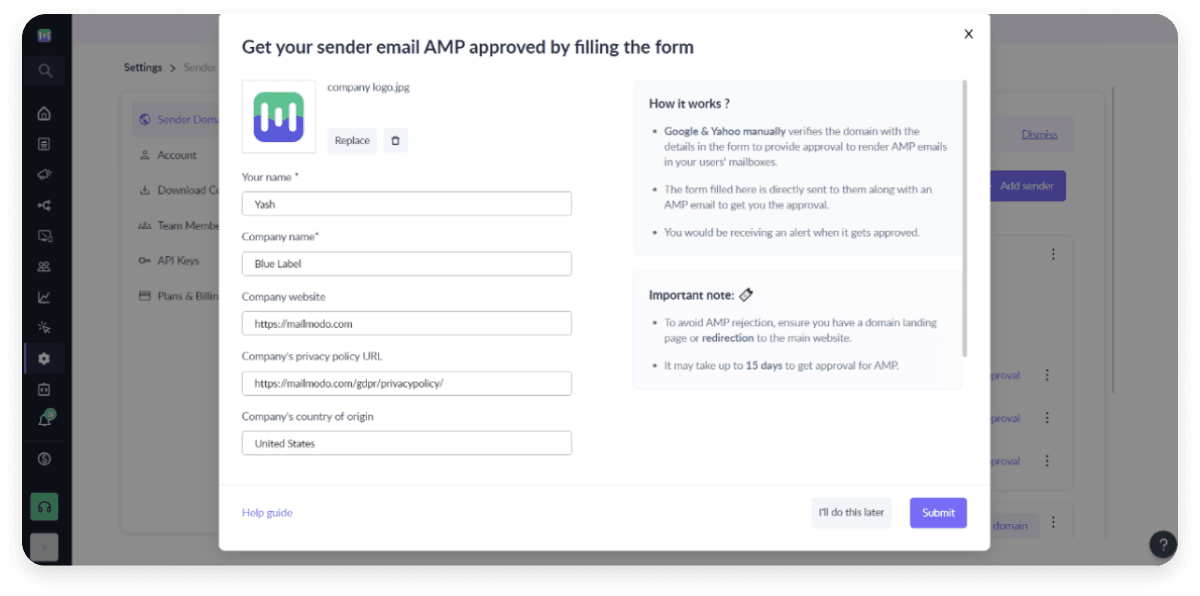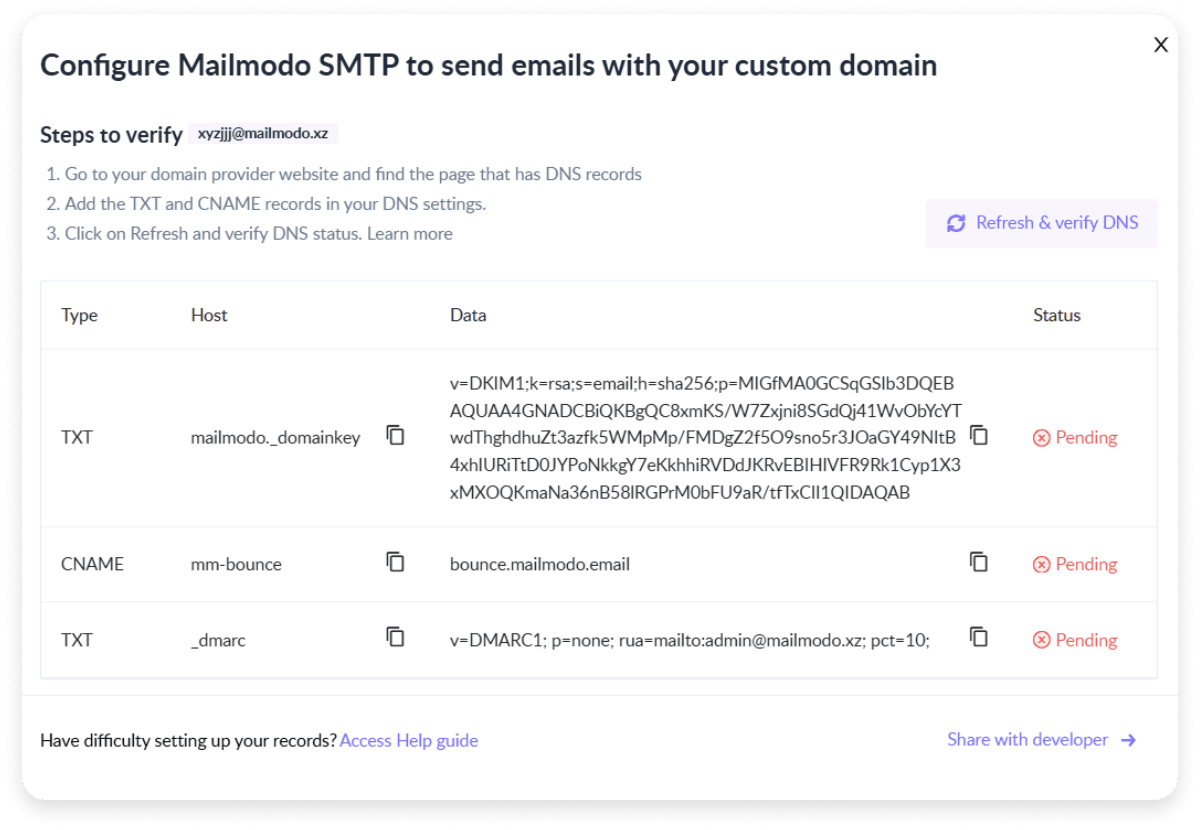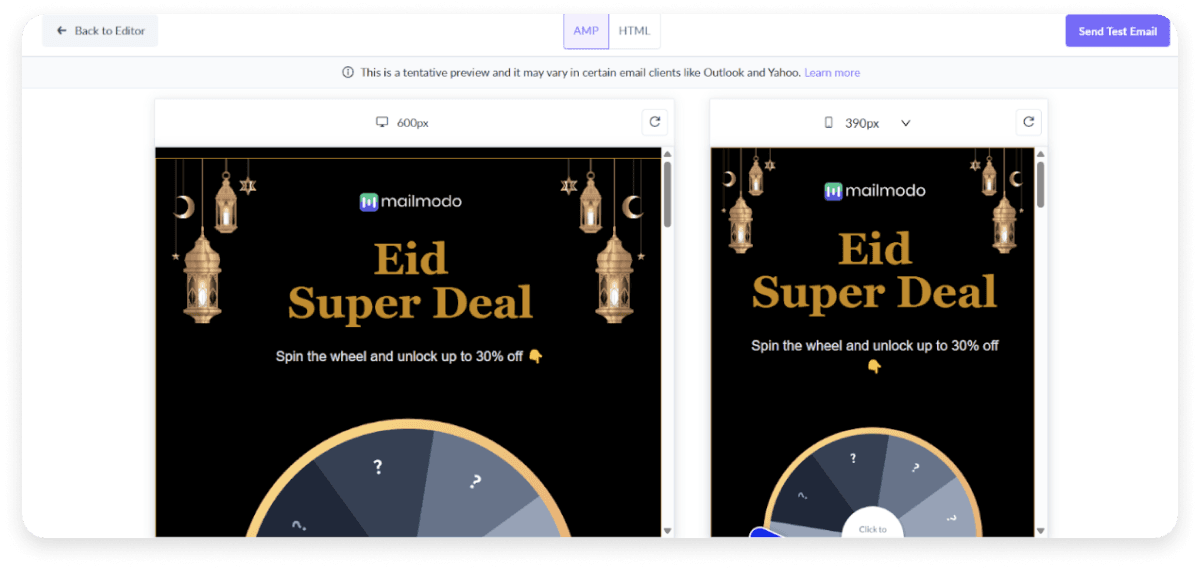Email clients that support AMP email rendering
Currently, only four major email clients support AMP emails, allowing users to enjoy the enhanced interactivity and engagement that AMP technology offers.
Here's an overview of AMP email rendering support for major email clients:
| Email Client |
Supported Email Clients |
| Apple Mail |
Not supported |
| Gmail |
Supported in iOS (2020-04) and Android (2020-04) |
| Outlook |
Not supported |
| Yahoo! Mail |
Supported in Desktop Webmail (2019-10, 2021-01 and 2022-02), iOS (2022-01) and Android (2022-12) |
| Samsung Email |
Not supported in Android |
| Mozilla Thunderbird |
Not supported in Mac OS |
| AOL |
Not supported in Desktop Webmail, macOS and Android |
| ProtonMail |
Not supported in Desktop Webmail, iOS and Android |
| Mail.ru |
Supported in Desktop Webmail (2020-10) |
| FairEmail |
Supported in Android (2022-02-14 onwards) |
Despite the benefits of AMP, not all email clients support this technology. Therefore, incorporating fallback templates is imperative to ensure consistent delivery and rendering across all platforms.
This addition ensures that if your email is received by a client supporting AMP for email, it will be rendered accordingly. Otherwise, the email client will display the HTML or plain text fallback version.
Email service providers (ESPs) support for AMP emails: Overview
Here's an overview of major Email service providers (ESPs) that support AMP emails:
| ESP |
No-Code Creator for AMP Emails |
Easy AMP Email Whitelisting Support |
AMP Email Sending Support |
Analytics or Submission Support |
| Mailmodo |
Yes |
Yes |
Yes |
Yes |
| Klaviyo |
No |
No |
Yes |
No |
| Mailchimp |
No |
No |
Yes |
No |
| AWeber |
No |
No |
Yes |
No |
| Twilio SendGrid |
No |
No |
Yes |
No |
| Dyspatch |
Yes |
No |
Yes |
No |
| Mailkit |
No |
No |
Yes |
No |
| SendPulse |
No |
No |
Yes |
No |
| Stripo |
Yes |
No |
No |
No |
ESPs that support creating AMP emails
To develop an HTML email template with AMP components, you'll need to incorporate specific HTML tags that enable interactive and dynamic features. These components allow you to include elements like forms, carousels, accordions, shopping carts, games, and more. So, choosing the right Email Service Provider (ESP) is crucial for your AMP email campaigns.
A drag-and-drop or WYSIWYG (What You See Is What You Get) email creator simplifies the process of designing complex, visually appealing, and interactive emails. This user-friendly feature allows anyone, regardless of technical expertise, to create professional-looking emails quickly and efficiently. The real-time previews ensure that your emails look polished and professional before sending. This ease of use speeds up the campaign creation process and ensures consistency and adherence to your brand's aesthetic.
Only a handful of ESPs support drag-and-drop AMP email creation:
- Mailmodo
- Stripo
- Dyspatch
- Appmails
Create and send AMP emails without coding in minutes
You can explore the diverse range of use cases you can effortlessly create with AMP emails in minutes using Mailmodo.
ESPs that support whitelisting AMP emails
Whitelisting your sender email ID is crucial for AMP email support, requiring approval from major clients like Gmail and Yahoo Mail to ensure successful delivery. Compliance with security protocols such as DKIM, DMARC, and SPF authentication certifications is also essential for sending AMP emails effectively.
Mailmodo currently supports whitelisting, making it easier to get your AMP emails approved and ready for distribution with minimal effort. Other ESPs don't provide this level of support, requiring manual processes for AMP email approval.
Here’s the simplified Mailmodo AMP email whitelisting support:
- Add sender ID: Enter your sender email ID into the Mailmodo platform.

- Submit domain details: Fill out a form with your domain information, privacy policy, logo, and other related details.

- Update DNS records: Follow Mailmodo’s instructions to update your SPF, DKIM, and DMARC records in your DNS settings.

- Mailmodo submission: Mailmodo sends a production-ready AMP email to Google for you.
- Receive approval notification: Mailmodo’s team notifies you via email once your sender ID is approved.
With other providers, you typically need to create the AMP email code yourself, perform the necessary authentications, and manually submit the email and related details to Google. This process can be complex and time-consuming.
You can read the detailed procedure of whitlisting AMP emails with Mailodo in our guide below.
💡 Related guide: Whitelisting your sender's address to start sending AMP emails
ESPs that support sending AMP emails
Many ESPs support the sending of AMP emails, allowing you to take advantage of their dynamic and interactive features.
Here's a look at ESPs that support sending AMP emails:
|
|
|
| Mailmodo |
Iterable |
eSputnik |
| Adobe Campaign Classic |
Mailgun |
Klaviyo |
| Amazon Pinpoint |
ExpertSender |
Braze |
| Blueshift |
dotdigital |
Customer.io |
| Twilio SendGrid |
Maileon |
MessageGears |
| Copernica |
Elastic Email |
Mailkit |
| Tripolis |
SendPulse |
ExpressPigeon |
| Amazon Simple Email Service (SES) |
Dyspatch |
MoonMail |
| Netcore Cloud |
SocketLabs |
Cheetah Digital |
| AWeber |
Mailrelay |
Mapp Cloud |
| Appmails |
MagNews |
SparkPost |
| MindBox |
Clang |
Salesforce Marketing Cloud |
Browsers that support AMP email rendering
For AMP emails to render correctly, they need to be viewed in browsers that support AMP technology. In scenarios where the recipient's browser is outdated or does not support AMP, there may be issues with the content display.
While many modern browsers offer this support, here is a list of the most commonly used ones:
| Browser |
AMP Email Rendering Support |
| Chrome |
Google's browser fully supports AMP, ensuring seamless rendering of AMP emails. |
| Firefox |
Mozilla's browser also provides support for AMP emails, offering a smooth viewing experience. |
| Safari |
Apple's browser supports AMP, allowing AMP emails to display correctly on macOS and iOS devices. |
| Opera |
Known for its speed and efficiency, Opera supports AMP emails, enhancing user interaction. |
| UC Browser |
Popular in Asia, UC Browser provides support for AMP emails, ensuring broad accessibility. |
| Microsoft Edge |
Microsoft Edge does not support AMP emails. |
Desktop, phone, tablet and web view versions of these browsers are also supported. However, limited support is available for iOS 8, the Android 4.0 system browser and Chrome 41.
5 additional requirements to keep in mind before hitting send on your AMP emails
AMP is a new and rapidly evolving technology. Here are a few things to keep in mind:
1. AMP emails have content restrictions
AMP emails enforce specific content restrictions to mitigate security risks and prevent malicious activities. For instance, executable code, forms, and JavaScript are prohibited in AMP emails to uphold security standards and ensure safe user experiences.
2. You should track customer engagement on AMP emails
Measuring elements like submissions and engagement of AMP components can be challenging in AMP emails. ESPs like Mailmodo offer a comprehensive dashboard to track all your email analytics. You can also track views separately for both AMP and HTML versions of emails.
3. You can’t stream videos inside AMP emails
Despite AMP's interactivity, playing videos within emails isn't universally supported. Only a handful of email clients, like Apple Mail, iOS 10, and the Samsung email client, support HTML5 video playback in emails. As a workaround, GIFs can be used instead to add motion to emails. Alternatively, including a link to your YouTube or video URL within the email is another option.
4. You should debug and preview AMP emails before sending
Once you've created your AMP emails, debug and preview them for correct rendering.
 Developers rely on debugging banners to pinpoint issues preventing certain parts of their emails from displaying as AMP emails. You can only do this if you have whitelisted your email domain.
Developers rely on debugging banners to pinpoint issues preventing certain parts of their emails from displaying as AMP emails. You can only do this if you have whitelisted your email domain.
It's a good idea to preview your emails to view your email's appearance in recipients' inboxes. You should test your AMP email across different environments. You can use tools like the AMP playground for validation to ensure a consistent and engaging experience for recipients.
You can read a detailed explanation of why your AMP emails might not be rendering, in our troubleshooting guide below.
💡 Related guide: Why is AMP not rendering?
5. Use dynamic content refresh in AMP Emails with caution
Dynamic content refresh in AMP emails allows for automatic updates to email content after it's been sent. However, overusing this feature can lead to recipient fatigue and potentially impact engagement. For instance, a travel company might update flight prices dynamically, but too frequent updates may overwhelm recipients. Strike a balance ensuring updates are timely and relevant.






 Developers rely on debugging banners to pinpoint issues preventing certain parts of their emails from displaying as AMP emails. You can only do this if you have whitelisted your email domain.
Developers rely on debugging banners to pinpoint issues preventing certain parts of their emails from displaying as AMP emails. You can only do this if you have whitelisted your email domain.






